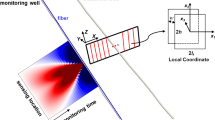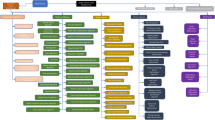Abstract
To reduce the computational cost of uncertainty propagation, multi-fidelity polynomial chaos approaches have been developed by fusing a few expensive high-fidelity data points and many less expensive lower-fidelity data points to build a stochastic metamodel. However, previous studies mainly focused on multi-model fusion. Systematically allocating sample points from multi-fidelity models to ensure both the accuracy and efficiency of the metamodel still remain challenging. To address this issue, a new maximum cost performance (MCP) sequential sampling strategy considering both the sample cost and accuracy improvement is proposed based on the recently developed multi-fidelity PC-Kriging (MF-PCK) approach. With the proposed sampling strategy, the input location with the largest prediction error is identified as the new input sample point, and then, the multi-fidelity model with the largest CP index is selected for evaluation to reduce the computational cost as much as possible. Furthermore, a sample density function is introduced to avoid the clustering of samples, which can prevent wastage of sample points and the singularity problem. The effectiveness and relative advantage of the proposed multi-fidelity sampling strategy in terms of efficiency is demonstrated by comparative studies using several numerical examples for uncertainty propagation and an airfoil robust optimization problem.

















Similar content being viewed by others
Abbreviations
- B :
-
polynomial coefficient matrix
- b t :
-
polynomial chaos coefficient vector of model with tth-level fidelity
- d :
-
dimension of random input vector
- d :
-
response sample dataset
- E :
-
covariance matrix between lower-fidelity models
- h,θ :
-
hyperparameters in the covariance function
- n t :
-
number of sample points for tth-level fidelity model
- R :
-
covariance function
- s :
-
highest-level fidelity
- s(x):
-
posterior standard deviation
- t :
-
tth-level fidelity
- x :
-
random input vector
- x a :
-
new input sample location
- y :
-
stochastic response
- δ(x):
-
correction function of multi-fidelity pc model
- ρ :
-
scaling factor
- σ :
-
standard deviation value
- Γ :
-
input sample dataset
- μ :
-
mean value
- ξ :
-
random vector in standard random space
- Φ:
-
orthogonal polynomial
- η :
-
sample density equation
- ε :
-
small positive number prespecified by users
- GP:
-
gaussian process
- PC:
-
polynomial chaos
- HF:
-
the high-fidelity model
- LF:
-
the low-fidelity model
- CP:
-
cost performance
References
Ahmar AM, Raisee M (2020) Multi-fidelity uncertainty quantification of film cooling flow under random operational and geometrical conditions. Int J Heat Mass Transf 152:119548. https://doi.org/10.1016/j.ijheatmasstransfer.2020.119548
Biehler J, Gee MW, Wall WA (2015) Towards efficient uncertainty quantification in complex and large-scale biomechanical problems based on a Bayesian multi-fidelity scheme. Biomech Model Mechanobiol 14:489–513. https://doi.org/10.1007/s10237-014-0618-0
Chen Z, Peng S, Li X, Qin H, Xiong H, Gao H, Li P (2015) An important boundary sampling method for reliability-based design optimization using kriging model. Struct Multidiscip Optim 52:55–70. https://doi.org/10.1007/s00158-014-1173-0
Chen S, Jiang Z, Yang S, Apley DW, Chen W (2016) Nonhierarchical multi-model fusion using spatial random processes. Int J Numer Methods Eng 106(7):503–526. https://doi.org/10.1002/nme.5123
Chen S, Jiang Z, Yang S, Chen W (2017) Multimodel fusion based sequential optimization. AIAA J 55(1):1–14. https://doi.org/10.2514/1.J054729
Cheng K, Lu ZZ, Zhen Y (2019) Multi-level multi-fidelity sparse polynomial chaos expansion based on Gaussian process regression. Comput Methods Appl Mech Eng 349:360–377. https://doi.org/10.1016/j.cma.2019.02.021
Gratiet LL, Cannamela C (2012) Kriging-based sequential design strategies using fast cross-validation techniques with extensions to multi-fidelity computer codes. Technometrics 57(3):418–427. https://doi.org/10.1080/00401706.2014.928233
Huang D, Allen T, Notz W, Miller RA (2006) Sequential kriging optimization using multiple-fidelity evaluations. Struct Multidiscip Optim 32(5):369–382. https://doi.org/10.1007/s00158-005-0587-0
Jofre L, Geraci G, Fairbanks HR (2018) Multi-fidelity uncertainty quantification strategies for large-scale multiphysics applications: PSAAP II particle-based solar energy receiver. AIP Conf Proc 1979(1):140002. https://doi.org/10.1063/1.5044952
Jone BA, Weisman R (2010) Multi-fidelity orbit uncertainty propagation. Acta Astronaut 155:406–417. https://doi.org/10.1016/j.actaastro.2018.10.023
Kaveh A, Dadras A, Geran Malek N (2019) Robust design optimization of laminated plates under uncertain bounded buckling loads. Struct Multidiscip Optim 59:877–891. https://doi.org/10.1007/s00158-018-2106-0
Kennedy MC, O'Hagan A (2000) Predicting the output from a complex computer code when fast approximations are available. Biometrika 87(1):1–13. https://doi.org/10.1093/biomet/87.1.1
Lee T, Bilionis I, Tepole AB (2019) Propagation of uncertainty in the mechanical and biological response of growing tissues using multi-fidelity Gaussian process regression. Comput Methods Appl Mech Eng 359:112724. https://doi.org/10.1016/j.cma.2019.112724
Liu Y, Chen S, Wang F, Xiong F (2018) Sequential optimization using multi-level cokriging and extended expected improvement criterion. Struct Multidiscip Optim 58:1155–1173. https://doi.org/10.1007/s00158-018-1959-6
Ng WT, Eldred M (2012) Multifidelity uncertainty quantification using nonintrusive polynomial chaos and stochastic collocation. AIAA/ASME/ASCE/AHS/ASC Structures, Structural Dynamics and Materials Conference, AIAA/ASME/AHS Adaptive Structures Conference, Honolulu, Hawaii, pp 23–26
Palar PS, Shimoyama K (2017) Multi-Fidelity uncertainty analysis in CFD using hierarchical Kriging. 35th AIAA Applied Aerodynamics Conference, Denver, pp 5–9. https://doi.org/10.2514/6.2017-3261
Rumpfkeil MP, Hanazaki K, Beran PS (2017) Construction of multi-fidelity locally optimized surrogate models for uncertainty quantification. 19th AIAA Non-Deterministic Approaches Conference, Grapevine, pp 9–13. https://doi.org/10.2514/6.2017-1948
Sasena MJ, Papalambros P, Goovaerts P (2002) Exploration of metamodeling sampling criteria for constrained global optimization. Eng Optim 34(3):263–278. https://doi.org/10.1080/03052150211751
Schoebi R, Sudret B, Wiart J (2015) Polynomial-chaos-based Kriging. Int J Uncertain Quantif 5(2):55–63. https://doi.org/10.1615/Int.J.UncertaintyQuantification.2015012467
Shah H, Hosder S, Koziel S (2015) Multi-fidelity robust aerodynamic design optimization under mixed uncertainty. Aerosp Sci Technol 45:17–29. https://doi.org/10.1016/j.ast.2015.04.011
Wang G, Liu P (2016) A Method of shape parameterization based on B-spline for wing design. Civil Aircr Des Res 3:6–15. (In Chinese). https://doi.org/10.19416/j.cnki.1674-9804.2016.03.002
Wang F, Xiong F, Chen S, Song J (2019) Multi-fidelity uncertainty propagation using polynomial chaos and Gaussian process modeling. Struct Multidiscip Optim 4(60):1583–1604. https://doi.org/10.1007/s00158-019-02287-7
Xiong F, Yang S, LIU Y, Chen S (2015) Analysis method of engineering probability uncertainty. Science Press, Beijing. https://doi.org/10.1016/j.tws.2007.05.007 (In Chinese)
Xiu D, Karniadakis GE (2002) The Wiener-Askey polynomial chaos for stochastic differential equations. SIAM J Sci Comput 24(2):619–644. https://doi.org/10.1137/S1064827501387826
Yan L, Zhou T (2019) Adaptive multi-fidelity polynomial chaos approach to Bayesian inference in inverse problems. J Comput Phys 381:110–128. https://doi.org/10.1016/j.jcp.2018.12.025
Yang Q, Meng S, Jin H, Xie W, Zhang X (2019) Multi-fidelity uncertainty quantification method with application to nonlinear structural response analysis. Appl Math Model 75:853–864. https://doi.org/10.1016/j.apm.2019.06.038
Yong HK, Wang L, David JJ, Keane AJ, Stanley F (2019) Multi-fidelity Kriging-assisted structural optimization of whole engine models employing medial meshes. Struct Multidiscip Optim 60:209–1226. https://doi.org/10.1007/s00158-019-02242-6
Acknowledgements
The work was supported by the National Numerical Wind Tunnel Project [grant number NNW2020ZT7-B31] and Science Challenge Project [grant number TZ2019001].
Author information
Authors and Affiliations
Corresponding author
Ethics declarations
Conflict of interest
The authors declare that they have no conflict of interest.
Replication of results
The results shown in the manuscript can be reproduced. Considering the size limit of the uploaded supplementary material, the codes for two of the mathematical examples for UP (Example 1 in Section 4.1.1 and Example 2 in Section 4.1.2) were uploaded as supplementary material. The remaining examples are easy to implement by changing the response functions and sample points based on the codes provided to obtain the results shown in the manuscript.
Additional information
Responsible Editor: Palaniappan Ramu
Publisher's note
Springer Nature remains neutral with regard to jurisdictional claims in published maps and institutional affiliations.
Supplementary Information
ESM 1
(ZIP 90.1 kb)
H,H p, T p, V p and V d for Hyperparameter Estimation
H,H p, T p, V p and V d for Hyperparameter Estimation
where Φm(Dj(ξ)) is a matrix of size nj × (P + 1) (j, m = 1,2, …,s), formulated as:
For the hierarchical-fidelity case,
For the mth diagonal block,
For the off-diagonal block,
For the nonhierarchical-fidelity case,
where ei is an (s−1)-dimensional unit column vector, where the ith element is 1, while the others are 0.
Rights and permissions
About this article
Cite this article
Ren, C., Xiong, F., Wang, F. et al. A maximum cost-performance sampling strategy for multi-fidelity PC-Kriging. Struct Multidisc Optim 64, 3381–3399 (2021). https://doi.org/10.1007/s00158-021-02994-0
Received:
Revised:
Accepted:
Published:
Issue Date:
DOI: https://doi.org/10.1007/s00158-021-02994-0




